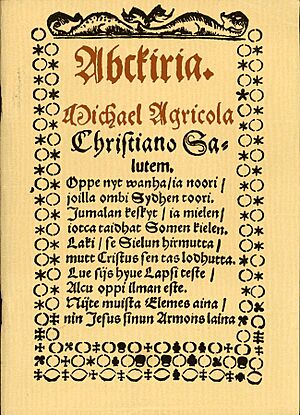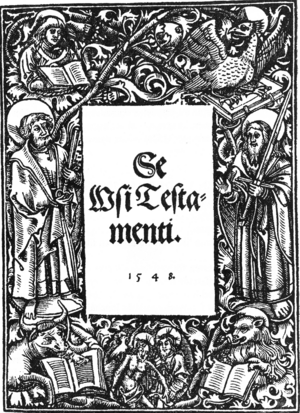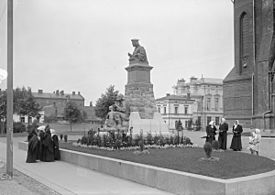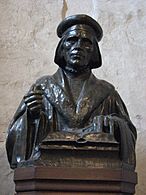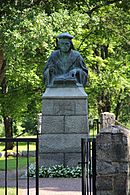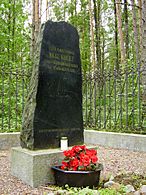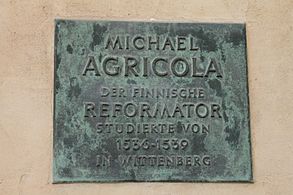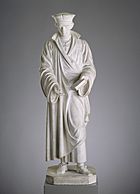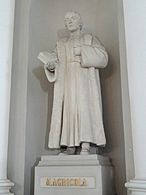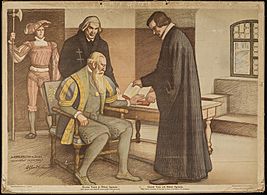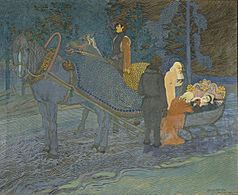Mikael Agricola facts for kids
Quick facts for kids Mikael Agricola |
|
|---|---|
| Bishop of Turku | |

Drawing of Mikael Agricola by Albert Edelfelt (1854–1900). No contemporary depictions of Agricola have survived.
|
|
| Church | Church of Sweden |
| Diocese | Turku |
| In Office | 1554–1557 |
| Predecessor | Martti Skytte |
| Successor | Petrus Follingius |
| Orders | |
| Ordination | 1531 |
| Consecration | 1554 by Botvid Sunesson |
| Personal details | |
| Born | c. 1510 Torsby, Pernå, Uusimaa (Nyland), Kalmar Union (now Finland) |
| Died | 9 April 1557 Uusikirkko, Karelia, Sweden (now Russia) |
| Nationality | Finnish |
| Denomination | Lutheran |
Mikael Agricola (c. 1510 – April 9, 1557) was a Finnish clergyman. He is known as the "father of literary Finnish." He helped create the written Finnish language.
Agricola was also a key person in the Protestant Reformation in Sweden, which included Finland at the time. He became the bishop of Turku in 1554. He worked to change the Finnish church to follow Lutheranism.
He translated the New Testament into Finnish. He also created a prayer book and hymns for the new Lutheran Church in Finland. His work set the rules for how Finnish is spelled today. He did all this important work in just three years.
Mikael Agricola died suddenly while returning from a trip. On this trip, he helped make a peace agreement with Tsardom of Russia.
Contents
Mikael Agricola's Life Story
Early Years and Education
Mikael Agricola was born around 1510 in a village called Torsby. This village was in Pernå, which is now part of Finland. At that time, Finland was part of the Kalmar Union, a group of Nordic kingdoms.
His birth name was Michael Olaui or Mikkel Olofsson. We don't know his exact birthday. His family was quite well-off. Mikael had three sisters, but their names are not known.
His teachers saw that he was good with languages. His rector, Bartholomeus, sent him to Vyborg for school. There, he learned Latin and trained to become a priest. It's not clear if his first language was Finnish or Swedish. However, he was very good at both.
Becoming a Scholar
When Michael studied in Vyborg, he chose the last name Agricola. This name means "farmer" in Latin. It was common for scholars back then to pick surnames based on their family's job.
In Vyborg, he first learned about the Protestant Reformation and Humanism. The castle in Vyborg was led by a German count named Johann. This count supported the Reformation, and Lutheran church services were already held there.
In 1528, Agricola moved to Turku, which was the main city in Finland. He became a scribe for Bishop Martinus Skytte. In Turku, Agricola met Petrus Särkilahti, who was the first Finnish student of Martin Luther. Särkilahti was spreading the ideas of the Reformation. When Särkilahti died in 1529, Agricola continued his work. Agricola became a priest in the early 1530s.
Studies in Germany
In 1536, the Bishop of Turku sent Agricola to study in Lutherstadt Wittenberg, Germany. He focused on the lessons of Philip Melanchthon, who was an expert in Greek. Greek was the original language of the New Testament.
In Wittenberg, Agricola also studied with Martin Luther himself. Both Luther and Melanchthon wrote letters to King Gustav I of Sweden to recommend Agricola. Agricola asked the King for money to help with his studies. When the money came, he bought many books, including all the works of Aristotle. In 1537, he began translating the New Testament into Finnish.
Rector and Bishop
Agricola returned to Turku in 1539. He became the rector, or head, of the Turku Cathedral School. He didn't enjoy this job much. He even called his students "untamed animals."
At this time, King Gustav Vasa was taking over church property to gain more power. He was also pushing the Reformation. In 1544, the King ordered Agricola to send talented young men to Stockholm. Agricola didn't obey right away, which likely made the King unhappy.
In 1546, Agricola lost his home and school in a big fire in Turku. By 1548, King Gustav Vasa told Agricola to leave his job as rector. Agricola was married by then, but we only know his wife's name was Pirjo Olavintytär. Their only son, Christian Agricola, was born in 1550. Christian later became a bishop too.
When the old bishop died in 1554, King Gustav Vasa made Agricola the new bishop of Turku. This made him the first Lutheran bishop for all of Finland. Agricola was not extremely strict, but he did remove parts of the old church service.
His Final Journey
In 1557, Agricola led a group on a trip to Russia. They were there to make a peace agreement called the Treaty of Novgorod (1557). He was in Moscow from February 21 to March 24.
On April 9, 1557, Agricola became sick and died. This happened near the village of Uusikirkko on the Karelian Isthmus. This day is now celebrated in Finland as the Day of the Finnish Language. Agricola was probably buried inside a church in Vyborg, but the exact spot is unknown.
Mikael Agricola's Written Works
The Abckiria
Agricola had wanted to translate the New Testament since he was young. But there was no standard way to write Finnish yet. So, he started to create one.
His first book was called Abckiria, which means "ABC book." It was a simple book to teach people how to read. It also included a catechism, which is a summary of Christian beliefs. This was important because most people could not afford a whole Bible. The first version was printed in 1543 and had 16 pages. A second version came out in 1551 with 24 pages.
Later, in 1966, a librarian found parts of a third, unknown edition of the Abckiria. It showed that this version was printed in 1559, after Agricola had died.
The Rucouskiria
Agricola's Rucouskiria Bibliasta was printed in March 1544. Its name means "Prayer Book from the Bible." At the start of the book, Agricola wrote about education and the Reformation in Finland.
The book has four introductions and about 700 prayers. It is Agricola's most original work and has about 900 pages. He used ideas from other thinkers like Martin Luther and Erasmus.
New Testament in Finnish
Agricola's most famous book is the first Finnish translation of the New Testament. He finished writing it in 1548. This book has 718 pages and many pictures.
Other Church Books
While Agricola was studying in Wittenberg, he translated three smaller church books into Finnish. These books were printed in 1549.
- Käsikirja Castesta ia muista Christikunnan Menoista included forms for baptisms, weddings, and burials. It also had speeches for sick or grieving people.
- Messu eli Herran echtolinen contained the form for a church service. In this book, Agricola shared his next goal: translating the Old Testament.
- Se meiden Herran Jesusen Christusen Pina, ylesnousemus ia tauiaisen Astumus, niste Neliest Euangelisterist coghottuon told the story of Jesus Christ's suffering. This book was put together from all four gospels.
Honoring Mikael Agricola
The Evangelical Lutheran Church in America remembers Bishop Agricola every year on April 10.
The Mikael Agricola Church in Helsinki is named after him. There is also an Agricola Lutheran Church in Toronto, Canada. An asteroid, 3212 Agricola, is also named after him.
In 2007, 450 years after his death, Finland made a special €10 coin. This coin honored Mikael Agricola and his work for the Finnish language. One side of the coin shows a quill, which is a pen, to represent him as a writer. The other side has an artistic picture of a person.
Gallery
-
1910 recast in the Turku Cathedral
-
1959 recast in Pernå (today part of Loviisa)
-
Plaque to Agricola in Wittenberg
-
Mikael Agricola Hands Over the Finnish Translation of the New Testament to King Gustav Wasa, Robert Wilhelm Ekman, 1853
See also
 In Spanish: Mikael Agricola para niños
In Spanish: Mikael Agricola para niños
- Flag flying days in Finland


